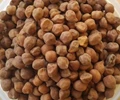
Global chickpea markets have been maintaining more or less firm trend since last few weeks and most sellers are of the opinion that average global prices shall tend to remain upward on the back of limited supplies/inventory of larger grades of Kabuli chickpeas. In major producing areas of Argentina the occurrence of drought caused by La Nina phenomenon, is forcing experts to expect a significant reduction in average yields and production of this year's crop. Similar situation had been observed in Russia last year.
The recently ended week has seen some firmness in Kabuli Chickpeas, while light export demand was noted for Desi chickpeas. Exporters’ sentiments have eased of late on decreasing prospects of imports from India, on the back of significant increase in production in Australia. Therefore rise in export possibility from Australia to India keeps exporters sentiments eased in other supplying nations.
On the domestic front, average trade offers for the NCDEX specified grades of Chickpeas/Chana are currently quoted near Rs.5200/qtl in Bikaner, and around Rs. 5300/qtl in Akola. Current prices are up more than Rs.1200 per quintal when compared with levels, averaging during April month. Improved demand from millers has improved as the un-lockdown phase has started. Millers have increasing their operating capacity now since transportation activities have increased due to unlocking of economic activities. On going festive season continues supporting the local demand situation.
Prices had turned expensive during last week of September therefore wholesale demand turned subdued. As a result prices have adjusted lower from September end offers, and at present the offers are down Rs.75-100/qtl in mandis of Bikaner and Akola, when compared with offers prevailing during the above mentioned period. As per trade sources, at prevailing rates, fresh buying interest amongst stockists is expected improve amongst stockists.
Government’s announcement of providing free Pulses to the poor till November shall be preventing any major fall in prices in coming weeks, since it has resulted in higher procurement by the Government agencies. There is no import parity till Rs. 6000-6500/qtl. Therefore chances of imports to occur are unlikely this year, thereby keeping supplies restricted. At the same time inflation is well under control so intervention from the Government is least likely as of now. Also the daily arrivals till date are quite lower than the daily arrivals during corresponding period of last year. This is indicative of the fact that farmers and stockists are still holding most of the produce (anticipating further price appreciation in near term). This also indicates that the actual production of Chana for year 2019-2020 may be lower (as estimated earlier), than the year before. Traders expect festival related demand to improve this week onwards. All these aspects shall be influential in keeping prices firm in near future.
Consumption continues under the PMGKAY scheme while demand for sowing will improve soon as the planting season approaches. Trade sources say that nearly 7-10 Lakh tonnes of Chana will be required additionally for planting of Chana. The sowing operation is expected to start in next few weeks. Only NAFED is reportedly having most of the inventories, and traders, stockists or millers are having limited number of inventories in hand as per market estimates. NAFED will not sell much now since it has to maintain sufficient buffer against any unfavorable scenario like sharp price spikes, crop production failure etc. All in all, supply remains limited against improving demand situation. As a result, traders and industry persons are maintaining a positive price outlook for domestic Chana in upcoming weeks.
















